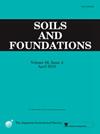粘性和砂质土中桩筏基础在竖向荷载作用下的使用性能
IF 3.3
2区 工程技术
Q2 ENGINEERING, GEOLOGICAL
引用次数: 0
摘要
本文采用三维有限元分析方法,研究了桩筏基础(或桩筏组合基础,CPRF)在不同土体中的使用性能。假定桩筏基础在竖向荷载作用下分别埋置于均质粘土和砂质土中。仔细观察了桩的位移和反力。通过对比土体刚度、筏板宽度、桩间距、桩长等因素的影响,发现基础埋深对桩的使用性能有显著影响。对于0米至12米的埋深,桩荷载可减少约40%至60%的基础荷载,具体取决于所涉及的桩数。土体中桩筏基础的位移随埋深的增加而减小。而在砂土中,埋深对地基位移的影响较小。计算了桩的荷载比和CPRF的位移比,证明了它们与桩长细比和桩数的关系。这两个比率都符合国际土力学与岩土工程学会(ISSMGE)为CPRF系统提出的指导方针。值得注意的是,筏板嵌入的深度引起了人们的注意,因为它对桩的响应有很大的影响。本文章由计算机程序翻译,如有差异,请以英文原文为准。
Serviceability performance of piled raft foundations under vertical loads in clayey and sandy soils
This study investigated the serviceability performance of piled raft foundations (or combined pile-raft foundations, CPRF) in various soils using three-dimensional (3D) finite element analysis. The piled raft foundation was assumed to be embedded respectively in homogeneous clayey soils and sandy soils under vertical loading. The displacements and reactions of the piles were carefully observed. In comparing the influences of soil stiffness, raft width, pile-to-pile spacing distance, and pile length, it was found that the embedment depth of the foundation could significantly affect the serviceability of the piles. For embedment depths ranging from 0 m to 12 m, the pile loads can be reduced by approximately 40 % to 60 % of the foundation load, depending on the number of piles involved. The displacements of piled raft foundations in clays decrease with increased embedment depth. However, the effects of embedment depth on foundation displacements are smaller in sands. Furthermore, the load ratio of the piles and the displacement ratio of the CPRF were calculated to demonstrate their dependence on the slenderness ratio of the piles and the number of piles. Both ratios aligned with the guidelines the International Society for Soil Mechanics and Geotechnical Engineering (ISSMGE) proposed for CPRF systems. Notably, attention is drawn to the depth of raft embedment, as it significantly influences pile responses.
求助全文
通过发布文献求助,成功后即可免费获取论文全文。
去求助
来源期刊

Soils and Foundations
工程技术-地球科学综合
CiteScore
6.40
自引率
8.10%
发文量
99
审稿时长
5 months
期刊介绍:
Soils and Foundations is one of the leading journals in the field of soil mechanics and geotechnical engineering. It is the official journal of the Japanese Geotechnical Society (JGS)., The journal publishes a variety of original research paper, technical reports, technical notes, as well as the state-of-the-art reports upon invitation by the Editor, in the fields of soil and rock mechanics, geotechnical engineering, and environmental geotechnics. Since the publication of Volume 1, No.1 issue in June 1960, Soils and Foundations will celebrate the 60th anniversary in the year of 2020.
Soils and Foundations welcomes theoretical as well as practical work associated with the aforementioned field(s). Case studies that describe the original and interdisciplinary work applicable to geotechnical engineering are particularly encouraged. Discussions to each of the published articles are also welcomed in order to provide an avenue in which opinions of peers may be fed back or exchanged. In providing latest expertise on a specific topic, one issue out of six per year on average was allocated to include selected papers from the International Symposia which were held in Japan as well as overseas.
 求助内容:
求助内容: 应助结果提醒方式:
应助结果提醒方式:


